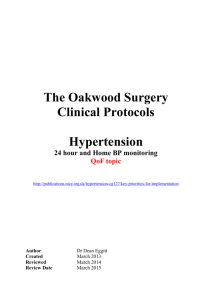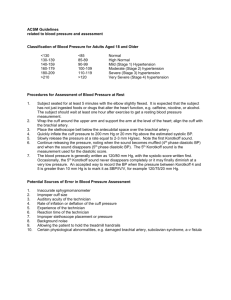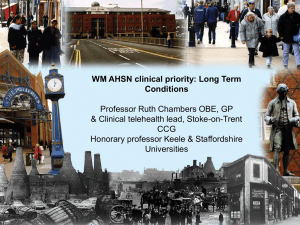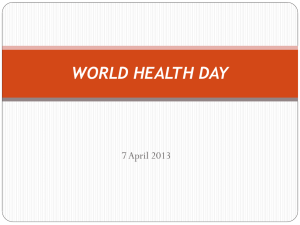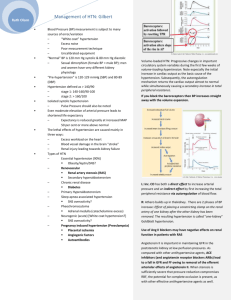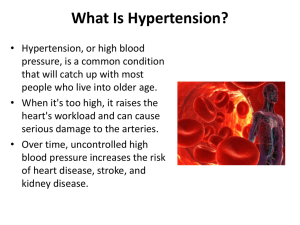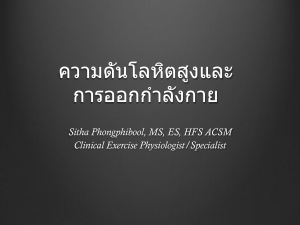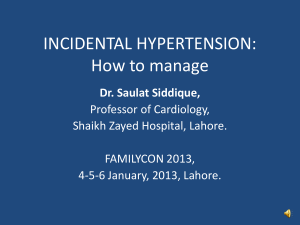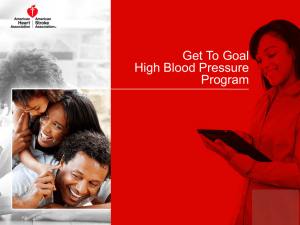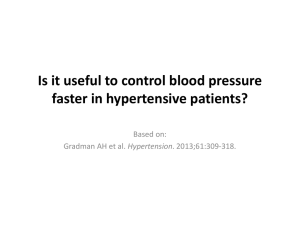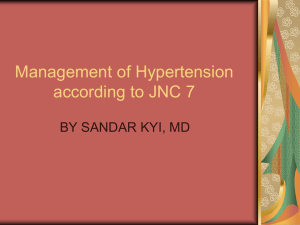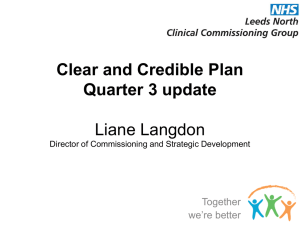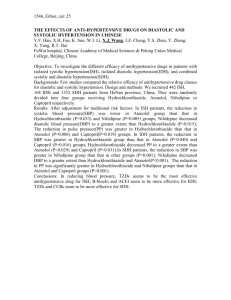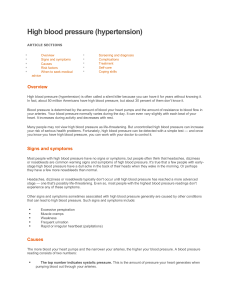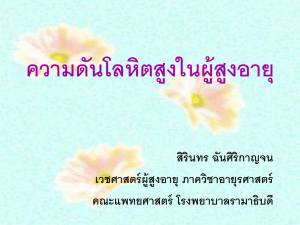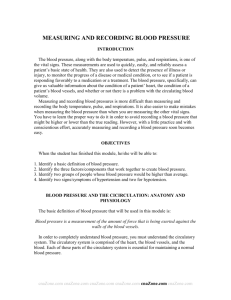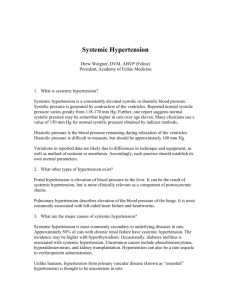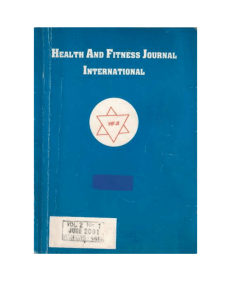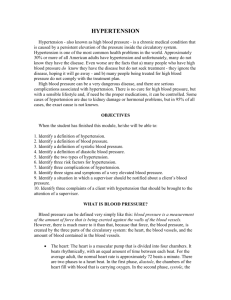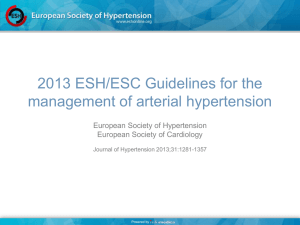Hypertension
advertisement
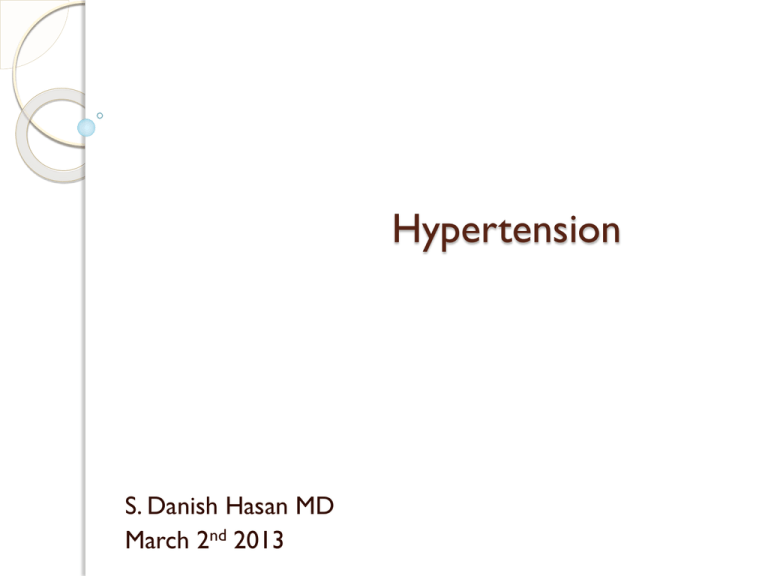
Hypertension S. Danish Hasan MD March 2nd 2013 Objectives Basic Concepts Definitions Screening and Diagnosis Guidelines Risk Factors Complications Treatment and Adverse Effects Basic Concepts Blood Pressure ◦ Amount of pressure on the arterial walls as the blood is pumped through them by the heart and circulated through the body Systolic Blood Pressure ◦ Pressure on the walls when the heart contracts Diastolic Blood Pressure ◦ Pressure on the walls when the heart is relaxed (in between heart beats) Basic Concepts Systolic goes on top and Diastolic on the Botton Example 120 = 80 Systolic Diastolic Definitions Normal Blood Pressure Pre Hypertension Stage 1 Hypertension Stage 2 Hypertension Isolated Systolic Hypertension Isolated Diastolic Hypertension Malignant Hypertension Hypertensive Urgency <120/<80 120-139/80-89 140-159/90-99 >159/99 >139/<90 <140/>89 End organ damage >179/>119 Definitions Primary/Essential Hypertension Hypertension without a known or identifiable cause Secondary/Identifiable Hypertension Hypertension with a known or identifiable cause. Some causes include: 1. Primary Renal Disease – AKD/CKD with glomerular or vascular disorders 2. OCPs 3. Drug induced – Chronic NSAID/Alcohol use/abuse, Antidepressants. 4. Pheochromocytoma (adrenal tumor) - paroxysmal hypertension 5. Primary hyperaldosteronism – htn(specially resistant), unexplained hypoK 6. Renovascular dz – pt. with atherosclerosis ex. Renal artery stenosis 7. Other Endocrine issues – hypo/hyperthyroidism, hyperparathyroid 8. Cushing’s Syndrome 9. OSA 10. Coarctation of aorta Screening and Diagnosis Screening ◦ Every 2 years for those in normal category ◦ Every year for pre-hypertensive category Who is diagnosed with HTN? ◦ Initial screen + ◦ 2 or more visits with documented high blood pressure ◦ Over a period of weeks to months ◦ Should be measured in both arms (>15mmHg difference = Subclavian stenosis/PAD) ◦ Postural BPs in >65, diabetics, dizziness weakness upon standing. Difference >20mmHg from supine to standing(Orthostatic Hypotension) Guidelines for proper blood pressure measurement Patient Conditions ◦ Posture ◦ Circumstances Equipment ◦ Cuff ◦ Manometer Technique ◦ Number of Readings ◦ Performance Recordings Guidelines – Posture Sitting pressures are recommended for routine follow-up; the patient should sit quietly with the back supported for five minutes and the arm supported at the level of the heart Check for postural changes by taking readings after five minutes supine, then immediately and two minutes after standing; this is particularly important in patients over age 65 years, diabetics, or those taking antihypertensive drugs Guidelines - Circumstances No caffeine during the hour preceding the reading no smoking during the preceding 30 minutes No exogenous adrenergic stimulants, such as phenylephrine in decongestants or eye drops for pupillary dilatation A quiet, warm setting Home readings should be taken upon varying circumstances (patient might be asked to keep a home log) Guidelines - Equipment Cuff size ◦ length of the bladder should be 80 percent ◦ width of the bladder should be at least 40 percent of the circumference of the upper arm Manometer ◦ Aneroid gauges should be calibrated every six months against a mercury manometer Guidelines – Number of Readings Take at least two readings on each visit separated by as much time as possible if readings vary by more than 5 mmHg, take additional reading until two consecutive readings are close For the diagnosis of hypertension take three readings at least one week apart Initially, take blood pressure in both arms; if pressures differ, use the higher arm If the arm pressure is elevated, take the pressure in one leg, particularly in patients under age 30 years Korotkoff Sounds–Reviewing BP 101 5 Phases Phase 1 – Clear Tapping Sound (SBP) Phase II – Swishing sound/soft murmur onset Phase III – Loup slapping/instense sound Phase IV – Sudden Muffling Sound Phase V – Silence Phase/Disappearance of Sound “Tap – Murmur – Slap – Muffle – Silence” Guidelines - Performance Inflate the bladder quickly to 20 mmHg above the systolic pressure as estimated from loss of radial pulse Deflate the bladder 3 mmHg per second Record the Korotkoff phase V (disappearance) as the diastolic pressure except in children in whom use of phase IV (muffling) may be preferable If the Korotkoff sounds are weak, have the patient raise the arm, open and close the hand five to ten times, and then inflate the bladder quickly Guidelines - Recording Recordings Note the pressure, patient position, arm, and cuff size: eg, 140/90, seated, right arm, large adult cuff Risk Factors – Non Modifiable Ethnicity - Asian, Inuit, First Nations/Aboriginal, African Americans ◦ Tends to be most common and most severe in Blacks Family History – mother, father or both parents Age >65 Certain personality traits, such as hostile attitudes and time urgency/impatience, as well as among those with depression Risk Factors - Modifiable Smoking Excessive alcohol use (>14 drinks for M and >9 drinks for F per week) Diet high in fat and salt (AHA <1500 mg) Weight / obesity Dyslipidemia regardless of obesity/weight Lack of exercise Vitamin D Deficiency Other medication Prime suspects are canned soups and lunch meat Complciations Complications CVD - Hypertension is quantitatively the major risk factor for premature CVD, being more common than cigarette smoking, dyslipidemia, or diabetes, the other major risk factors. In older patients, systolic pressure and pulse pressure are more powerful determinants of risk than diastolic pressure . CHF - The risk of heart failure increases with the degree of blood pressure elevation. Dysrythmias, MI, Sudden Cardiac Death – LVH is a common finding in patients with hypertension, and is associated with an enhanced incidence of heart failure, ventricular arrhythmias, death following myocardial infarction, and sudden cardiac death. Ischemic Stroke - Hypertension is the most common and most important risk factor for ischemic stroke, the incidence of which can be markedly reduced by effective antihypertensive therapy. Intracerebral hemorrhage - Hypertension is the most important risk factor for the development of intracerebral hemorrhage. CKD/ESRD - Hypertension is a risk factor for chronic kidney disease and end-stage renal disease. It can both directly cause kidney disease, called hypertensive nephrosclerosis, and accelerate the progression of a variety of underlying renal diseases. Treatments Diet Exercise Dieuretics Beta Blockers ACE-Inhibitors ARBs Calcium Channel Blockers Other Medications Complementary Therapies Treatment – Lifestyle, Diet and Exercise DASH Diet – Dietary Approaches to Stop Hypertension ◦ eating more fruits, vegetables, whole-grain foods, low-fat dairy, fish, poultry, and nuts. You should eat less red meat, saturated fats, and sweets. Reducing sodium in your diet can also have a significant effect. Exercise ◦ 50 minutes of moderate exercise per week - gardening, walking briskly, bicycling, or other aerobic exercise. Muscle-strengthening activities are recommended at least two days a week and should work all major muscle groups. Lifestyle ◦ Quit smoking and alcohol Treatment - Diuretics Often the first choice if diet and exercise changes aren't enough Also called "water pills” Help the body shed excess sodium and water Side Effects: ◦ urinate more often ◦ some may deplete potassium, causing muscle weakness, leg cramps, and fatigue ◦ Some can increase blood sugar levels in diabetics ◦ Erectile dysfunction is a less common side effect hydrochlorothiazide (HydroDiuril), furosemide (Lasix), spironolactone (Aldactone) Treatment – beta-Blockers Slows the heart rate Used to treat other heart conditions May be prescribed along with other medications Side effects: insomnia, dizziness, fatigue, cold hands and feet, and erectile dysfunction. atenolol (Tenormin), metoprolol (Betaloc/Lopressor), bisoprolol Treatment – ACE Inhibitors ACE inhibitors reduce your body's supply of angiotensin II -- a substance that makes blood vessels contract and narrow. The result is more relaxed, open (dilated) arteries, Side effects: dry cough, skin rash, or dizziness, and high levels of potassium. Women should not become pregnant while taking an ACE inhibitor(teratogenic). lisinopril (Zestril), perindopril, enalapril, ramipril (Altace) Treatment - ARBs Block receptors for angiotensin -- as if placing a shield over a lock Prevents artery-tightening effects, and lowers your blood pressure. ARBs can take several weeks to become fully effective. Side effects: dizziness, muscle cramps, insomnia, and high levels of potassium Teratogenic as well. candesartan (Atacand), losartan (Cozaar), valsartan (Diovan) Treatment – Calcium Channel Blockers Slow the movement of calcium into the cells of the heart and blood vessels. Since calcium causes stronger heart contractions, these medications ease the heart's contraction and relax the blood vessels. Side Effects: dizziness, heart palpitations, swelling of the ankles, and constipation. Take with food or milk and avoid grapefruit juice and alcohol because of possible interactions. amlodipine (Norvasc), diltiazem (Cardizem), felodipine (Renedil) Other Medications Other medications that relax the blood vessels include vasodilators, alpha blockers, and central agonists. Side effects: dizziness, a fast heart beat or heart palpitations, headaches, or diarrhea. Usually if HTN is not controlled or if another comorbitity Complimentary Therapies Along with lifestyle, diet and exercise these help for HTN Yoga tai chi deep breathing exercises Other relaxation techniques Herbal Remedies? Unproven benefits and some actually increase blood pressure. Questions?

